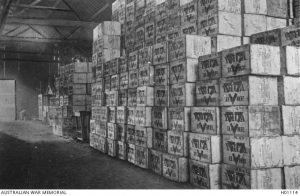
Anzac tile or wafer recipe
The army biscuit, also known as an Anzac wafer or Anzac tile, is essentially a long shelf-life, hard tack biscuit, eaten as a substitute for bread. Unlike bread, though, the biscuits are very, very hard. Some soldiers preferred to grind them up and eat as porridge.
The following recipe has been supplied courtesy of Arnott’s Biscuits Limited, through Frank Townsend, Chief Chemist. Originally, the biscuits were baked in large industrial ovens but the recipe has been altered so that one can bake them in a domestic oven.
Ingredients:
- 200 gm/1.5cups flour
- 400 gm/3 cups wholemeal flour
- 40 gm/5 tbls sugar
- 20 gm/3 tbls milk powder
- 1.5 gm/good pinch salt
- 220 mls water
Use self-raising flours. If self-raising flours are not available, sieve 10 grams of baking powder together with plain flour before adding other ingredients.
Method
Place flour, sugar, and milk powder in a large bowl and blend with finger tips.
Form into pile and scoop out a hole (well) in the centre.
Add all of the water in which the salt has been dissolved.
Thoroughly work the flour from the inside of the well into the water until the whole is a mass of lumps of flour and water. Once the dough is formed, transfer it to a table top or pastry board.
The dough should now be torn apart, rubbed into balls, and thrown together, and the process repeated until the mass is well mixed and in the form of a hard dough.
The dough is then rested for about half an hour.
Now roll the dough in 8 mm–thick sheets using a rolling pin and two 8–mm thick guides (wooden slats are ideal), the dough being rolled down between the two guides until the rolling pin rests on the guides during each traverse.
The rolled sheet of dough is then cut into 90 mm squares, preferably by pressing with the edge of a steel rule rather than slicing with a knife. The pressing action helps to join the top and bottom surfaces and will improve the lift on baking. A cardboard square, 90 mm on each side, can be used as a pattern to ensure uniformity in your tiles.
Next, the biscuit squares should be docked by having a regular horizontal and vertical pattern of holes pushed into them at about 18 mm spaces with a flat-ended pin or rod. Push it in until it bottoms, twist slightly, and then withdraw.
Repeat at the next position.
Each biscuit should have five vertical and five horizontal rows of docker holes, 25 holes in all. There are those at the Memorial who argue for 49 holes (7 x 7) as the authentic number of docker holes.
Place on a lightly greased steel baking sheet, with the biscuits about 6 mm apart, and form a wall around the load with scrap dough to avoid burning the edges of the biscuits. Bake at about 200 degrees centigrade for 30 to 40 minutes on a low shelf in the oven. Take care not to burn them. To achieve a suitable hardness in your biscuits, store for a time in an air-tight container.
Copied from The Australian War Memorial website
